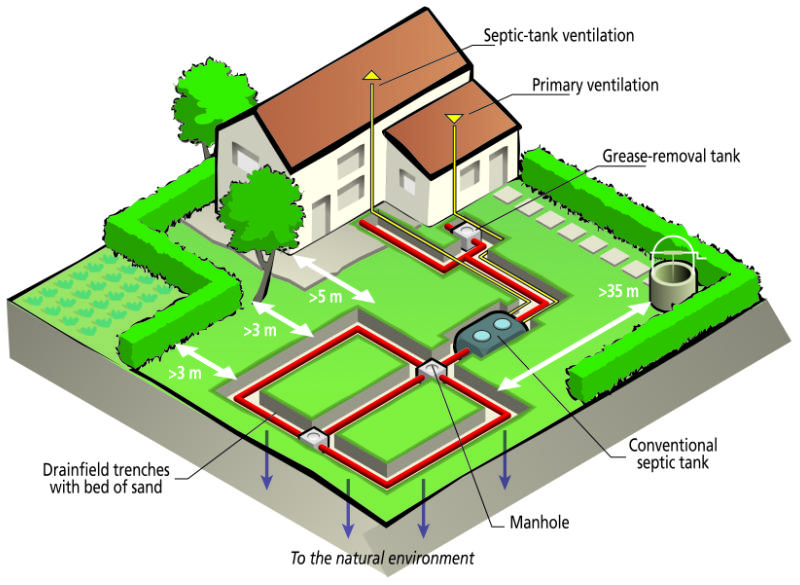 A septic system is a natural approach to the collection, treatment and disposal of wastewater in a home that is located in areas where there is no city or county sewage system. If it is properly installed and well maintained it is an efficient and cost effective method of household wastewater management. If you’re a homeowner with a septic system in your home, it is important for you to have some basic knowledge on what the system involves; what it is made up of, how it works and how to keep it in good working order. This knowledge could save you a lot of anxiety and even money in the future.
A septic system is a natural approach to the collection, treatment and disposal of wastewater in a home that is located in areas where there is no city or county sewage system. If it is properly installed and well maintained it is an efficient and cost effective method of household wastewater management. If you’re a homeowner with a septic system in your home, it is important for you to have some basic knowledge on what the system involves; what it is made up of, how it works and how to keep it in good working order. This knowledge could save you a lot of anxiety and even money in the future.
For Septic System Maintenance in Mount Tabor, NJ Call (866) 268-1769
-

Service was great and they respected all of my requests as far as cleanliness.
 Archie
Archie

-

Professional staff. Efficient work
 Indhira
Indhira

The two major components of a typical septic system are the septic tank and the drain field or leaching bed.
Septic Tank
A septic tank is a major component of a septic system. Traditionally, a septic tank is made by digging a rectangular chamber in the ground close to the house. The chamber is lined with bricks or mortar and the inner walls are lined with asphalt or bitumen to ensure that it is water tight. Other traditional septic tanks are made of pre-fabricated concrete. In the last 15 to 20 years, however, septic tanks are fabricated using polyethylene or fiber glass material. These fabricated septic tanks are also buried underground close to the house. Some septic tanks have two chambers while others have only one chamber. Its size and volume content vary depending on the size of the house and the volume of wastewater usage but it generally is ranges from 4,000 to 7,500 liters in size.
The septic tank is where all the household wastewater flows. It has an inlet pipe at one end where the wastewater from the home enters the tank and an outlet pipe connected to a drain field or leaching field on the other side. Generally, these pipes are designed as T pipes to allow the entry and exit of wastewater without agitating the crust or scum on the surface. Inside the tank the wastewater separates into three parts; the heavy solid waste settles at the bottom of the tank and becomes the sludge, the lighter waste such as grease and fat float upward to form the surface scum and the clearer liquid in the middle runs off through the outlet pipe into the leaching field. Inside the tank, the solid waste is broken down and digested by anaerobic bacteria that inhabit the tank.
Leaching Field or Drain Field
Every time new wastewater enters the septic tank, the semi-treated clear liquid in the middle of the tank is pushed out of the outlet pipe towards the leach or drain field also called an absorption field. A typical leach field is a network of gravel trenches where perforated distribution pipes are laid. This is where the next treatment occurs. The water passes through a distribution box that evenly distributes the water over each pipe. The sidewalls and bottom of the pipes are coated with aerobic bacteria that digest the remaining germs and microorganisms in the wastewater. Some of the treated wastewater is absorbed by the soil and some evaporates into the air. It is therefore a must that a drain field is laid in permeable soil or soil with absorptive capability. A leach fields should be overlaid with soil and landscaped.
One of the keys to having a trouble free septic system is proper maintenance. At SewerMan of Mount Tabor, NJ we are specialists in maintaining septic systems and in treating septic system emergencies. Call us today for your septic system needs.

